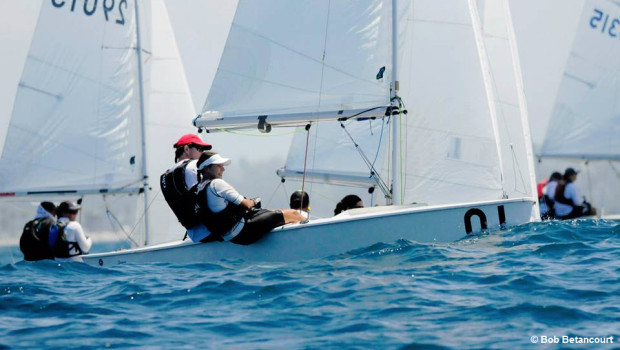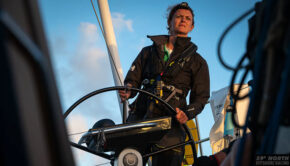Life jackets save lives, but only if sailors wear them
Published on August 17th, 2015
by Chris Caswell, Sailing Magazine
 I’ll tell you right now what this column is about: Don’t do as I did, do as I say. As She Who Must Be Obeyed would happily agree, I’ve been a complete idiot many times in my life and I now realize I’m very lucky to be alive.
I’ll tell you right now what this column is about: Don’t do as I did, do as I say. As She Who Must Be Obeyed would happily agree, I’ve been a complete idiot many times in my life and I now realize I’m very lucky to be alive.
It happened in a millisecond. One moment I was standing by the rail of our 40-foot ocean racer looking up at the spinnaker, the next instant I was upside down heading for the cold, blue sea. I’d been standing by the rail, just outside the staysail sheet that suddenly snapped taut when the sail filled.
Later, the crew said they wished they had score cards to hold up, because they all would have given me perfect 10s for my gymnastic backflip into the drink. It was near dusk when I went overboard, wearing seaboots and the pants to my foul weather suit, plus a heavy wool sweater.
But no life jacket.
Several things were in my favor. I was young and fit. Our crew had trained for just such an event, although there is a big difference between throwing a cushion overboard and trying to retrieve a soggy man. And I owed a couple of them money, so there was an incentive to retrieve me promptly.
I managed to get out of the sea boots and sweater, but I still felt as though I was swathed in cotton from my heavy clothing and I was swallowing a lot of seawater. I will tell you this: There is nothing more frightening than watching the stern of your boat disappear over a swell. But our crew blew the chute, had someone watching me constantly, brought the boat back, and yanked me bodily out of the hungry sea. It was by the book. I was lucky.
This came back to me recently with the news stories about Rob Konrad, the ex-Miami Dolphins football player, who slipped and fell overboard from his 36-footer while it was on autopilot in the Gulf Stream off Florida. He swam for 15 hours in shark- and jellyfish-infested waters to finally drag himself ashore. Although he was singlehanding, he wasn’t wearing a life jacket. He was lucky.
Not so lucky was Eric Tabarly, the legendary French ocean racing sailor who also went backward into the cold Irish Sea one night, and his crew wasn’t able to find him in the rough water. He wasn’t wearing a life jacket or safety harness in spite of the conditions.
Not so lucky was Larry Klein, an Olympic sailor and Soling champion, who went backward into San Francisco Bay during a race, wearing boots, foul weather gear and a thick shirt. But no life jacket. I’d seen Larry in the parking lot that morning and a few hours later he was gone.
Also not so lucky was Makota Namba, the Japanese America’s Cup skipper, who went overboard during a rough ocean race. Like Tabarly, he wasn’t wearing either a life jacket or a safety harness.
These were needless tragedies. The tale of my overboard swim became the basis for endless jokes and more than a few rounds bought at the bar for the crew that rescued me, but it could have had a grim ending.
I was arrogant and thought I could never fall overboard.
From my years on the water, I’ve learned one indisputable fact: you can die if you go overboard without a life jacket. Tabarly, Klein and Namba were hugely experienced sailors, yet their time ran out because they hadn’t taken a simple precaution. They weren’t wearing life jackets.
Do you really think you could get into a heated swimming pool and do 25 laps without touching bottom? You’ve only covered a few hundred feet, yet you’re probably in trouble. And you’re not wearing foulies or boots or a sweater, either.
Thirty-five years ago when I did my perfect gainer over the rail, life jackets weren’t often worn because they hadn’t improved much since the Titanic went down. They were big and bulky and, to be honest, probably more likely to cause you to go overboard than to save you.
Today, folks, there’s absolutely no excuse for not wearing a life vest. They’re lightweight, comfortable and, after they’ve been on for a few minutes, unnoticeable. Many inflate automatically if you’re unconscious, and they are designed to hold your head out of the water. And they look cool too.
If you’re sailing offshore, get a life jacket that has a built-in harness, so you can clip onto the boat and move around safely. I find, particularly in light of my background, that wearing (and using) a harness gives me a sense of freedom. I always have “one hand for myself and one for the boat,” but the harness is a comforting insurance policy.
Something that all the sailing schools need to teach—and many do—is that wearing a life jacket isn’t being “chicken.” There should be no stigma to putting on a life jacket the minute you step aboard. It should be as natural a part of sailing as wearing nonslip shoes or putting on sun block. And a word to skippers out there: You should lead the charge by being the first to put on your life vest and, for your occasional guests, have a couple of extras on board for their use.
We need to build a sailing mentality that it’s not cool to leave your life vest below. In the case of life jackets, being cocky is being an idiot.
As Dirty Harry said, “You’ve gotta ask yourself one question: Do I feel lucky? Well, do ya, punk?”
Re-published from Sailing Magazine. Look for additional columns here.










 We’ll keep your information safe.
We’ll keep your information safe.